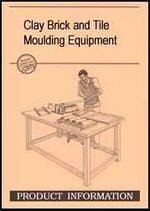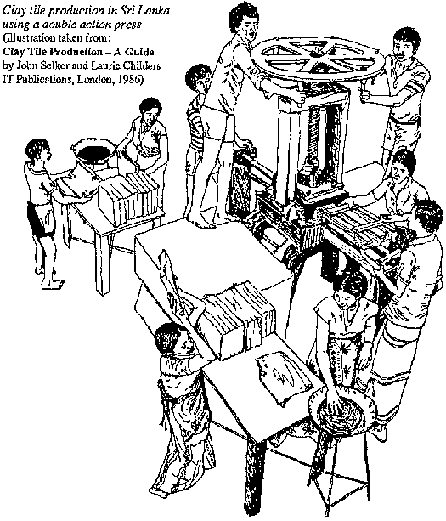Criteria for selection and purchase[edit | edit source]
General Considerations
In view of the vast choice of machines available, it seems difficult to decide which one should be bought. If there is not enough money to buy expensive equipment, the choice is smaller and the decision much easier. But generally, the following points need to be considered, especially when the available resources allow for the purchase of higher priced equipment.
Design of Moulding Equipment
- The moulding of bricks and tiles is only apart of the manufacture of ceramic products. For the rest of the process additional equipment is needed, such as clay crushers, pugmills (machines for mixing wet clay ready for moulding), racks for stacking fresh products, pallets and transportation equipment, and the like.
- Of special importance with regard to production efficiency and output rate is the spatial arrangement and organization of the various working areas. Some equipment suppliers offer complete production units with a system of machines and equipment that can be combined to form a production line, which is tailored to the user's requirements.
- In some cases, it may be advantageous to provide sufficient flexibility in such a way that other products can be manufactured with the same equipment, for instance by changing the moulds and using other raw materials, say to produce stabilized soil blocks. If the purchase of such a machine is contemplated, the speed and ease of changing moulds is an important selection criterium, but it must also be remembered, that this operation becomes rather difficult, the more moulds there are, as for example in the case of rotating tables, which have 3 or 4 moulds.
- Special consideration should be given to the working conditions for the production team, especially with regard to operation procedures and handling of products, that is, avoidance of dangerous or exceptionally hard manual work and activities that have to be done in a bent position.
- A balance must be found between the desired output rate, quality standard and level of sophistication. Complicated mechanical and electronic control devices often necessitate special training and experience for maintenance and repairs. Spare parts are usually expensive and difficult to procure (import).
Energy Sources
- Smaller moulding equipment is invariably manually operated (muscle power), while larger units are usually motorized (electric motor, diesel, or petrol engine). Manual equipment depends on the strength, stamina and motivation of the operator, while mechanized presses overcome the problems of human fatigue and non-uniform products.
- Energy transmission to the raw material, other than throwing or tamping, can be via a lever, toggle, cam, pivot, ball and socket joint, piston, auger (Archimedean screw) etc. But principally there are two systems of energy transmission: mechanical and hydraulic.
- Mechanical systems are usually simple but can be relatively heavy, unless special alloys are used, in which case repairs may be difficult.
- Hydraulic systems are susceptible to dust, sand and heat, under harsh conditions the hydraulic fluid must be changed once a month, so that maintenance can be difficult and costly. The systems are usually designed for operating temperatures around 70° C, but under tropical conditions temperatures can reach 120° C, requiring cooling mechanisms and/or special spare parts and oils to withstand the heat. Flexible tubing, joints, etc. that need frequent replacement should best be standardized.
Material Quality
- In order to maintain a consistently good quality of clay bricks and tiles, it is necessary to cheek the composition of the raw material and its moisture content at regular intervals before moulding. Finished products with deformations, broken edges, etc are a sure sign that the raw material was of inferior quality.
- Good quality bricks produce a ringing sound when knocked against each other. A dull sound is an indication that the bricks are cracked or underfired.
- A common defect of bricks is "lime blowing" (or "lime bursting"), leading to a weakening and breakage of the bricks. This is caused by the hydration of quicklime particles present in the clay. The problem can be minimized by reducing the paricle size of the raw mix and firing at 1000°C. The addition of 0.5 to 0.75% of common salt (sodium chloride) before firing has also proved effective.
Brick and Tile Dimensions
- For a mason to work efficiently, he should be able to hold the brick in one hand, hence a convenient width is between 100 and 120 mm. Generally, the length of a brick is twice its width plus the thickness of one mortar joint (10 mm).
- Small brick sizes require a greater number of bricks per cubic metre than larger ones, so the overall effort needed to produce small bricks is greater than that of making larger ones. Furthermore, masonry constructions with small bricks require more mortar, since the proportion of joints is higher. However, large bricks may not only be too heavy for the mason to handle, but also more difficult to fire in a kiln. If large blocks are to be used, they are usually machine-extruded perforated blocks, which are generally expensive, of high quality, and used for special purposes, eg to provide thermally insulated walls. But in general, perforated blocks reduce the drying time, facilitate uniform firing and improve the mortar bond in masonry.
- Indents (so-called "frogs") into one bed face of the bricks make the bricks lighter, also improve the mortar bond and provide a means to introduce an individual design and brand name.
- Burnt clay tiles can be plain or shaped, depending on the use to which they are put, either for flooring, wall cladding or for a large variety of roofing. Thus the number of possible shapes and sizes is too great to deal with here.
- Certain machines can produce a complete range of products (large and small blocks, paving and roofing tiles, etc.) which is a distinct advantage, but which has its price. Similarly, extruders can be supplied with different dies (mouth pieces) for the manufacture of products with different cross-sections.
Productivity and Manual Work
- The machine's output is often indicated according to the theoretical production cycle. The real productivity in the field is different and depends upon a number of factors that are totally independent of the machine's theoretical capacity, eg breakdown time, manpower organization, maintenance, etc. Real productivity lies quite often around or under 50 % of the theoretical production cycle.
- Since the methods of manufacturing bricks and tiles are so diverse, it is not possible to generalize on the amount of manual work required, but in all cases it is advisable to employ a few more workers than specified by the equipment supplier, in order to incorporate enough production flexibility.
- Special attention should be given to safety measures, such as avoidance of projecting moving parts, designing manual operations such that hands cannot get jammed between moving parts, clearly marking and/or protecting dangerous points, incorporating thermal fuses, security pins, etc. Automatic machines must at all cost tee equipped with an emergency stop switch, which is easily accessible.
Manufacturer
- Equipment suppliers for brick and tile plants range from small to large companies, with varying degrees of commercialization, offering a very diverse choice of products and services. The larger companies are usually better known, experienced in international trade and consequently reliable business partners. Small firms or their machines are often not so well-known, because of small advertising budgets, hence their list of references can be small in spite of a good product.
- Personal visits to the manufacturer and/or sites at which their machines are in use should be undertaken as far as possible. The value of reference lists is to be able to meet or correspond with users, to learn about their experiences. If such lists do not contain addresses, these should be specifically asked for.
- Of special advantage are training courses, offered by some manufacturers. To be effective, they should not only include the production of bricks and tiles, as well as handling and maintenance of the equipment, but also the testing and use of problem clays, as well as production management and design guidelines for building construction. Trainees should also learn to dismantle and assemble complicated machines, in order to understand their function and conduct repairs by themselves.
Purchase of Machine
- The "FOB" price (free on board) includes packaging, transportation and insurance costs of the machine within the retailer's country. This price can be artificially inflated in order to compensate for the reduction offered on the factory price.
- As regards sales or rental con<litions, one must be suspicious of contracts providing for price indexing based on the number of bricks and tiles produced or for payment of royalties for patent use, which is often not justified. A patent is no/necessarily a proof of guaranteed quality and constructors frequently apply for patents for processes that are already of the public domain.
- It is advisable to include a penalty clause in the contract, to safeguard against late delivery.
- In the case of an after sales service contract, the waiting period for repairs and maintenance must be clearly indicated. A detailed handbook should be provided, including specifications of all spare parts and a maintenance plan, indicating operations necessary and expected maintenance frequency.
FIGURE

